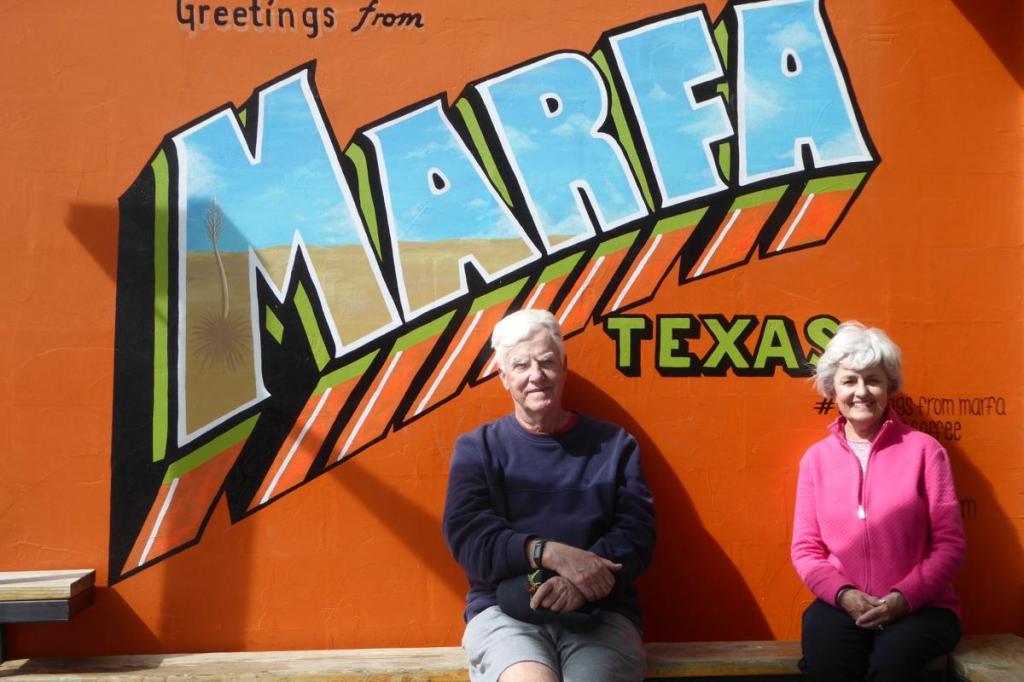Marfa: A very unusual Texas community
Published 5:00 pm Wednesday, October 23, 2019

- Authors David and Kay Scott relax outside a Marfa coffeeshop.
In planning a trip to West Texas we scheduled a full day for exploring Marfa, a remote community of under 2,000 people located three hours southeast of El Paso. The area has long fascinated residents and visitors alike with its mysterious “Marfa lights” that appear in the southern night sky.
More recently Marfa has become a magnet for artists and creative individuals seeking solitude in the high desert of West Texas.
We had previously visited Marfa on several occasions, but only with quick stops during journeys to Big Bend National Park. During this trip we intended to spend more time exploring the town in order to gain a better appreciation for a very unusual community.
Despite oil riches, West Texas is sparsely populated. At one time, Presidio County, in which Mara is located, covered nearly 22,000 square miles — approximately the size of Delaware — with under 600 residents. The county was subsequently subdivided into multiple counties until today it is just under 4,000 square miles in size — still large by most standards, but not what it once was.
Presidio’s current county seat of Marfa was established in 1883 when the Galveston, Harrisburg and San Antonio Railway required a water stop and site for its freight headquarters. Although never very large, the town’s population inched upward into the 1940s when it became home to a U.S. Army chemical warfare unit, the Marfa Army Airfield and a POW camp for captured German soldiers. Closure of the facilities following the war led to a long-term decline in population that local officials continue to battle.
Today’s Marfa is our kind of town: uncrowded, easy to walk, and filled with plentiful parking, small businesses, and interesting residents.
It is within driving distance of other worthwhile destinations including Big Bend National Park, the ghost town of Terlingua, McDonald Observatory, Fort Davis National Historic Site, and Museum of the Big Bend.
Marfa’s two major draws are its extensive art scene and the famed “Marfa lights.” The latter may not be particularly surprising considering the area is about four hours from Roswell, New Mexico, a town noted for alien landing lore.
However, the art scene seems strangely misplaced in this isolated West Texas setting. There is yet another attraction for those of us sufficiently old to welcome monthly Social Security checks: The area served as the primary location for production of the 1956 movie epic “Giant” starring Rock Hudson, Elizabeth Taylor and James Dean, all of whom resided here during 44 days of filming.
Marfa’s mysterious lights date to the late 1880s when they were mentioned by a cowboy during a cattle drive. Numerous subsequent sightings have been reported by settlers, military personnel, pilots and others. On a clear night the twinkling lights sometimes dance about while splitting apart, reattaching and eventually disappearing. They occasionally return for a repeat performance. The phenomenon is perhaps best described as the Northern Lights meet the high plains of West Texas. A rest stop and visitor center nine miles east of town on U.S. 90 was built for viewing the lights.
The town’s road to art prominence commenced in 1973 when New York artist Donald Judd began purchasing Marfa property for permanent display of his work along with that of contemporaries. The artist, who concentrated in three-dimensional work, acquired substantial property in and around Marfa, including two large U.S. Army hangers and several surrounding ranches.
The cornerstone of Marfa’s art is the Chinati Foundation’s contemporary art museum founded by Judd and opened to the public in 1986. Tours of the collection of work by 13 artists are offered ($25 adults, $10 students) Wednesday through Sunday. Numerous galleries and studios are scattered around town. Particularly notable are three huge Andy Warhol paintings of the Last Supper displayed in the Brite Building (no charge).
Following a morning arrival, our first stop was Marfa’s visitor center. Located in a remodeled WWII USO building, the interior walls are decorated with historic photos of Marfa and the town’s former military facilities. The former USO theater in the building’s rear is little changed since being abandoned by the military following the war. Personal photos of military veterans associated with Marfa fill the theater walls.
Picking up a town map and several brochures we headed to the south side of town for a visit to El Cosmico, an unusual lodging facility that describes itself as a Bohemian West Texas Nomadic Hotel. Overnight guests can choose among safari tents, teepees, yurts and over a dozen handsomely restored historic trailers. It’s almost impossible not to smile while walking through the facility that seems a perfect fit for the town.
Then it was back to town to visit the galleries, stores, historic 1886 Presidio County courthouse and the beautiful Hotel Paisano that served as headquarters during Warner Brothers filming of movie classic “Giant.” Elizabeth Taylor, Rock Hudson and James Dean stayed in the hotel for two weeks before moving to private residences. The hotel opened in 1931 and is filled with movie-related photos. We must have spent nearly an hour browsing the lobby and hallways while enjoying the old photographs.
The final stop was at Cobra Rock, a small shop where an enterprising young couple craft leather boots and accessories. During our visit co-owner Colt Miller worked on a pair of boots while discussing the firm’s history.
Departing Marfa, we headed a few miles west to view large cutouts of the house and cast members of “Giant.” This served as a fitting end for our visit to an unusual West Texas community that searches for a path to the future while preserving and celebrating its history.
— The Scotts are authors of “Complete Guide to the National Park Lodges” (Globe Pequot). Visit mypages.valdosta.edu/dlscott/Scott.html for more information.




